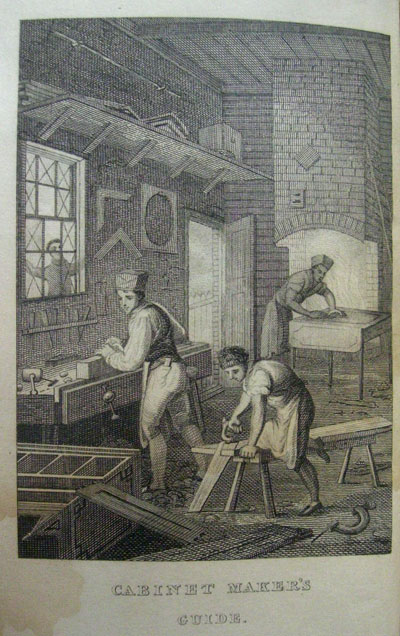 Here is the frontispiece from G. A. Siddon's 1833 "The Cabinet Maker's Guide" It's an interesting book, mostly about finishing, that we will reprint in a few months, but that's not the reason for this post. Please notice three things: Two of the workman are wearing paper hats, the workbench has a continuous double screw vise running along the front, and the handsaw is open handled. The first observations about the hats is the current topic of this blog. The second observation might be of interest because there has been lots of various blog posts on benches lately and here is another form of the English bench. Finally, while the book is from 1833 the engraving is probably at least ten years earlier (probably more) and the image reflects the transition from early open handle handsaw design of the 18th century to the more familiar closed handled handsaws of the 19th century. Both of the latter observations are worth writing about sometime in the future but now I just want to talk about hats!! Here is the frontispiece from G. A. Siddon's 1833 "The Cabinet Maker's Guide" It's an interesting book, mostly about finishing, that we will reprint in a few months, but that's not the reason for this post. Please notice three things: Two of the workman are wearing paper hats, the workbench has a continuous double screw vise running along the front, and the handsaw is open handled. The first observations about the hats is the current topic of this blog. The second observation might be of interest because there has been lots of various blog posts on benches lately and here is another form of the English bench. Finally, while the book is from 1833 the engraving is probably at least ten years earlier (probably more) and the image reflects the transition from early open handle handsaw design of the 18th century to the more familiar closed handled handsaws of the 19th century. Both of the latter observations are worth writing about sometime in the future but now I just want to talk about hats!!
The folded paper hats that these men are wearing are pretty typical headcoverings for workmen in the 19th and later centuries. They might have worn them earlier but certainly the introduction of mass produced paper in the 19th century made them cheap and disposable. In the newspaper industry pressmen were known to wear them until recently. In Lewis Carroll's "Alice in Wonderland" The carpenter walking on the beach is wearing a paper hat courtesy of John Tenniel the illustrator. Interestingly the hats here, in Alice, and in a couple of other sources I know of have big wide sides. I don't know if that's a reflection of paper size at the time or a vocational thing where carpenters wore bigger hats than printers, or if it is just random.
This illustration is one of the few contemporary illustrations that show the hat. There are bunches of ways of making them, and here is a link to step by step instructions.
The reason of course everyone in the 19th century covered their hair was that people didn't wash very frequency - no running water, poor soaps, and the complications of taking a bath when neither the shower or the bathroom had been invented gave everyone an incentive to try to keep their hair clean. Of course for a gentleman a regular hat would work fine but for anyone working in a shop with dust and grime from the shop everywhere a disposable head covering was far for useful. Hence the paper hat. Even today they can be a simple way of protecting your hair from dust and paint.
|
 Joel's Blog
Joel's Blog Built-It Blog
Built-It Blog Video Roundup
Video Roundup Classes & Events
Classes & Events Work Magazine
Work Magazine


 Here is the frontispiece from G. A. Siddon's 1833 "The Cabinet Maker's Guide" It's an interesting book, mostly about finishing, that we will reprint in a few months, but that's not the reason for this post. Please notice three things: Two of the workman are wearing paper hats, the workbench has a continuous double screw vise running along the front, and the handsaw is open handled. The first observations about the hats is the current topic of this blog. The second observation might be of interest because there has been lots of various blog posts on benches lately and here is another form of the English bench. Finally, while the book is from 1833 the engraving is probably at least ten years earlier (probably more) and the image reflects the transition from early open handle handsaw design of the 18th century to the more familiar closed handled handsaws of the 19th century. Both of the latter observations are worth writing about sometime in the future but now I just want to talk about hats!!
Here is the frontispiece from G. A. Siddon's 1833 "The Cabinet Maker's Guide" It's an interesting book, mostly about finishing, that we will reprint in a few months, but that's not the reason for this post. Please notice three things: Two of the workman are wearing paper hats, the workbench has a continuous double screw vise running along the front, and the handsaw is open handled. The first observations about the hats is the current topic of this blog. The second observation might be of interest because there has been lots of various blog posts on benches lately and here is another form of the English bench. Finally, while the book is from 1833 the engraving is probably at least ten years earlier (probably more) and the image reflects the transition from early open handle handsaw design of the 18th century to the more familiar closed handled handsaws of the 19th century. Both of the latter observations are worth writing about sometime in the future but now I just want to talk about hats!!
Great picture. The front chop of the vise looks like it would flex and not grip well.
Stephen
My grandfather worked in the printing industry building newspaper printing presses and he and his crew wore paper hats. He would make them for me and eventually taught me how to make them when I was a child. When I asked him why they all wore them he told me to keep their hair out of their eyes and to keep them safe from getting it caught in moving equipment. Those were the days before OSHA and often they were working inside presses while they were running. I can remember being with him once when they were replacing presses at the New York Times Press and being amazed seeing people crawling in and out of running presses!
Does this mean that the next time I come to Brooklyn and vist you from Arizona you and your crew will be wearing these nifty hats. BTW does the coice of newspaper matter? IE: Wall Street Journal, NY Times, National Inquirer? LOL
Mark
So I'm volunteering as a joiner at a local museum that interprets the 1850s this summer. I start this weekend. Are you telling me I need to make one of these hats to be authentic. Is using the comics section a faux pas?
Definitely not the cartoons - in 1850 they would not have had color. Blank paper seems to be what was used because ink could run.
I became a woodworker about 3 years ago after a lifetime of Electrical Contractor. During this time I have had the opportunity to watch Carpenters build additions and new construction, after watching for a long time it never looked that hard to do...until I tried some of it. Since my transition into Woodworking I have gained a new respect for this trade. Patience is one thing I had a hard time learning but getting into hand made Dovetails has given me a new look on life at least as far as patience goes.
The more I learn about this trade the more fascinated I become with it, I have most of the power tools required but find myself using hand tools more and more, and the motors are starting to collect more and more dust.
Thanks for such an interesting and informative blog.